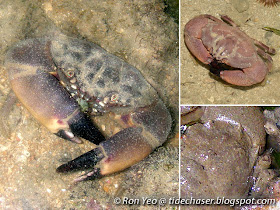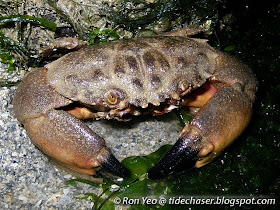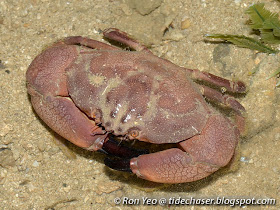Stone crabs (phylum Arthropoda, subphylum Crustacea, class Malacostraca, order Decapoda, superfamily Eriphioidea, family Menippidae) are commonly found in rocky areas or reef flats.

Their carapace is usually somewhat hexagonal to ovate, and the side margins nearer to the front is usually marked with crested teeth (i.e. the top surface of the teeth is not flat, but ridge-like, somewhat like the corner of a roof, as shown in the left-bottom picture). They typically have large and powerful asymmetrical chelipeds (i.e. the clawed arms), and a large molar-like tooth can be found near the base of the top finger, allowing them to crush and break shells of molluscan prey.
Like other true crabs, stone crabs have a broad carapace, and a very short and flattened abdomen which is usually folded underneath the body. They also have five pairs of "legs" (including the clawed arms, or chelipeds), and hence they are placed in the order Decapoda ("deca" means "ten", while "poda" means "feet"). The gills are leaf-like - a distinctive characteristic of decapods from the suborder Pleocyemata. And as with other crustaceans from the class Malacostraca, their body comprises three main parts - a head with five segments, a thorax with eight segments, and an abdomen with six segments. The head is fused to the thorax, forming a cephalothorax. They have a tough exoskeleton strengthened with calcium carbonate, and the carapace covers the gills but not the abdomen.
Stone crabs reproduce sexually, and have separate sexes. They mate face-to-face, usually with the male on top and the female below. The females can usually be distinguished from the males by having a broader abdomen. This is an adaptation to allow them to carry the eggs under their abdomen until they hatch.
Stone crabs are sometimes confused with rubble crabs (family Xanthidae), mud crabs (Scylla spp.), and other crabs of the same superfamily Eriphioidea [such as forceps crabs (family Oziidae) and red-eyed crabs (family Eriphiidae)]. Unlike rubble crabs, stone crabs have a large molar-like tooth near the base of the top finger of each pincer. They can be easily distinguished from the mud crabs by the lack of paddle-like back legs found in the latter. They can also be distinguished from other crabs of the superfamily Eriphioidea by having crested teeth by the sides of the carapace.
Here are some of the stone crabs that can be seen Singapore.

The Thunder Crab (Myomenippe hardwickii) has an ovate carapace covered with numerous tiny granules. The colour ranges from a dirty brown to sometimes reddish brown. It can be distinguished from other similar-looking crabs by its green eyes. The Thunder Crab is usually found in mangroves or rocky shores, sometimes hiding under rocks or in crevices. Its massive claws with the large molar-like tooth can be found near the base of the top finger allow it to crush shelled prey and other small animals to feed on. The carapace gets to about 10cm wide. The Thunder Crab gets its common name from the belief that once it gets its claws on a human, only a clap of thunder can make it release its grip. This is certainly not true. If a person gets pinched by a Thunder Crab, it is best to put the crab into water, and with luck it may release its grip. If not, he/she may have to pull off the claw and pry it open.

The colour of Thunder Crabs may vary, depending on the habitat, and the above photo features one with a more reddish brown coloration. The green eyes distinguish it from other similar species though. This species is often collected for food. Sometimes, fishermen may just detach the massive claws, and throw the animals back into the water. It is often more common to only see the claws being sold in the market rather than the entire animal.

The Maroon Stone Crab (Menippe rumphii), sometimes also called the Red Stone Crab, can be distinguished from the previous species by its red eyes. It is usually pinkish red or maroon in colour. This crab grows to about 9cm wide (carapace only), and like the previous species, usually only the claws are retained for sale in the market. It feeds on small animals, including shelled invertebrates, which it crushes with its massive claws.
References

Their carapace is usually somewhat hexagonal to ovate, and the side margins nearer to the front is usually marked with crested teeth (i.e. the top surface of the teeth is not flat, but ridge-like, somewhat like the corner of a roof, as shown in the left-bottom picture). They typically have large and powerful asymmetrical chelipeds (i.e. the clawed arms), and a large molar-like tooth can be found near the base of the top finger, allowing them to crush and break shells of molluscan prey.
Like other true crabs, stone crabs have a broad carapace, and a very short and flattened abdomen which is usually folded underneath the body. They also have five pairs of "legs" (including the clawed arms, or chelipeds), and hence they are placed in the order Decapoda ("deca" means "ten", while "poda" means "feet"). The gills are leaf-like - a distinctive characteristic of decapods from the suborder Pleocyemata. And as with other crustaceans from the class Malacostraca, their body comprises three main parts - a head with five segments, a thorax with eight segments, and an abdomen with six segments. The head is fused to the thorax, forming a cephalothorax. They have a tough exoskeleton strengthened with calcium carbonate, and the carapace covers the gills but not the abdomen.
Stone crabs reproduce sexually, and have separate sexes. They mate face-to-face, usually with the male on top and the female below. The females can usually be distinguished from the males by having a broader abdomen. This is an adaptation to allow them to carry the eggs under their abdomen until they hatch.
Stone crabs are sometimes confused with rubble crabs (family Xanthidae), mud crabs (Scylla spp.), and other crabs of the same superfamily Eriphioidea [such as forceps crabs (family Oziidae) and red-eyed crabs (family Eriphiidae)]. Unlike rubble crabs, stone crabs have a large molar-like tooth near the base of the top finger of each pincer. They can be easily distinguished from the mud crabs by the lack of paddle-like back legs found in the latter. They can also be distinguished from other crabs of the superfamily Eriphioidea by having crested teeth by the sides of the carapace.
Here are some of the stone crabs that can be seen Singapore.

The Thunder Crab (Myomenippe hardwickii) has an ovate carapace covered with numerous tiny granules. The colour ranges from a dirty brown to sometimes reddish brown. It can be distinguished from other similar-looking crabs by its green eyes. The Thunder Crab is usually found in mangroves or rocky shores, sometimes hiding under rocks or in crevices. Its massive claws with the large molar-like tooth can be found near the base of the top finger allow it to crush shelled prey and other small animals to feed on. The carapace gets to about 10cm wide. The Thunder Crab gets its common name from the belief that once it gets its claws on a human, only a clap of thunder can make it release its grip. This is certainly not true. If a person gets pinched by a Thunder Crab, it is best to put the crab into water, and with luck it may release its grip. If not, he/she may have to pull off the claw and pry it open.

The colour of Thunder Crabs may vary, depending on the habitat, and the above photo features one with a more reddish brown coloration. The green eyes distinguish it from other similar species though. This species is often collected for food. Sometimes, fishermen may just detach the massive claws, and throw the animals back into the water. It is often more common to only see the claws being sold in the market rather than the entire animal.

The Maroon Stone Crab (Menippe rumphii), sometimes also called the Red Stone Crab, can be distinguished from the previous species by its red eyes. It is usually pinkish red or maroon in colour. This crab grows to about 9cm wide (carapace only), and like the previous species, usually only the claws are retained for sale in the market. It feeds on small animals, including shelled invertebrates, which it crushes with its massive claws.
References
- Carpenter, K. E. & V. H. Niem (eds), 1998-2001. FAO species identification guide for fishery purposes. The living marine resources of the Western Central Pacific. Volumes 1 to 6. FAO, Rome. pp. 1-4218.
- De Grave, S., N. D. Pentcheff , S. T. Ahyong, T.-Y. Chan, K. A. Crandall, P. C. Dworschak, D. L. Felder, R. M. Feldmann, C. H. J. M. Fransen, L. Y. D. Goulding, R. Lemaitre, M. E. Y. Low, J. W. Martin, P. K. L. Ng, C. E. Schweitzer, S. H. Tan, D. Tshudy & R. Wetzer. 2009. A classification of living and fossil genera of decapod crustaceans. The Raffles Bulletin of Zoology, supplement 21, pp. 1-109.
- Debelius, H. 1999. Crustacea - Guide of the world. IKAN, Frankfurt. 321pp.
- Ng, P. K. L., L. K. Wang & K. K. P. Lim (eds.). 2008. Private Lives: An Exposé of Singapore’s Mangroves. The Raffles Museum of Biodiversity Research, Department of Biological Sciences, National University of Singapore. 240 pp.
- Ng, P. K. L., S. S. L. Lim, L. K. Wang & L. W. H. Tan. 2007. Private lives: An exposé of Singapore's shores. The Raffles Museum of Biodiversity Research, Department of Biological Sciences, National University of Singapore. 212 pp.
- Ng, P. K .L., R. T. Corlett & H.T.W. Tan (eds.). 2011. Singapore biodiversity: An encyclopedia of the natural environment and sustainable development. Singapore: Editions Didier Millet. 552 pp.
- World Register of Marine Species. 2012. Retrieved Jun 10, 2013, from http://www.marinespecies.org.

No comments:
Post a Comment